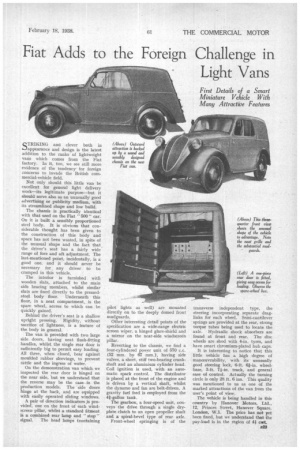Fiat Adds to the Foreign Challenge in Light Vans
Page 33

If you've noticed an error in this article please click here to report it so we can fix it.
QTRLKING and clever both in e....lappearance and design is the latest addition to the ranks of lightweight vans which comes from the Fiat factory. In it, too, we see still more evidence of the tendencyfor foreign concerns to invade the British commercial-vehicle field.
Not only should this little van be excellent for general light delivery work—its legitimate purpose—but it should serve also as an unusually good advertising or publicity medium, with its streamlined shape and low build.
The chassis is practically identical with that used on the Fiat "500" car. On it is built a sensibly proportioned steel body. It is obvious that considerable thought has been given to the construction of this body and space has not been wasted, in spite of the unusual shape and the fact that. the driver's seat has a fairly wide range of fore and aft adjustment. The last-mentioned point, incidentally, is a good one, and it should never be necessary for any driver to be cramped in this vehicle.
The interior is furnished with wooden slats, attached to the main side bracing members, whilst similar slats are fixed directly to the pressedsteel body floor. Underneath this floor, in a neat compartment, is the spare wheel, access to which can be quickly gained.
Behind the driver's seat is a shallow upright pressing. Rigidity, without sacrifice of lightness, is a feature of the body in general.
The van is provided with two large side doors, having neat flush-fitting handles, whilst the single rear door is sufficiently big to permit easy loading. All three, when closed, bear against moulded rubber sleevings, to prevent rattle and the ingress of water.
On the demonstration van which we inspected the rear door is hinged on the near side, but we understand that the reverse may be the case in the production models. The side doors hinge at the heck, and are equipped with easily operated sliding windows.
A pair of direction indicators is provided', one on the front of each windscreen pillar, whilst a standard fitment is a combined rear lamp and " stop " signal. The head lamps (containing pilot lights as well) are mounted directly on to the deeply domed front mudguards.
Other interesting detail points of the specification are a wide-range electric screen wiper, a hinged glare-shield and a mirror on the near-side windscreen pillar.
Reverting to the chassis, we find a four-cylindered power unit of 570 c.c. (52 mm. by 67 mm.), having side valves, a short, stiff two-bearing crankshaft and an aluminium cylinder head. Coil ignition is used, with an automatic spark control. The distributor is placed at the front of the engine and is driven by a vertical shaft, whilst the dynamo and fan are belt-driven. A gravity fuel feed is employed from the 4f-gallon tank.
The gearbox, a four-speed unit, conveys the drive through a single dryplate clutch to an open propeller shaft and a spiral-bevel type of rear axle.
Front-wheel springing is of the transverse independent type, the steering incorporating separate draglinks for each wheel. Semi-cantilever springs are provided at the rear, strong torque tubes being used to locate the axle. Hydraulic shock absorbers are found at front and rear. The disc wheels are shod with 4-in. tyres, and have smart chromium-plated hub caps.
It is interesting to notice that this tittle vehicle has a high degree of manceuvrability, with its unusually good steering lock, 6-ft. eel-in. wheelbase, 3-ft. 74-in, track, and general ease of control. Actually the turning circle is only 28 ft. 6 ins. This quality was mentioned to us as one of the marked attractions of the van from the user's point of view.
The vehicle is being handled in this country by Hanover Motors, Ltd., 12, Princes Street, Hanover Square, London, W.1. The price has not yet been fixed, but we understand that the pay-load is in the region of 44 cwt.




















































































